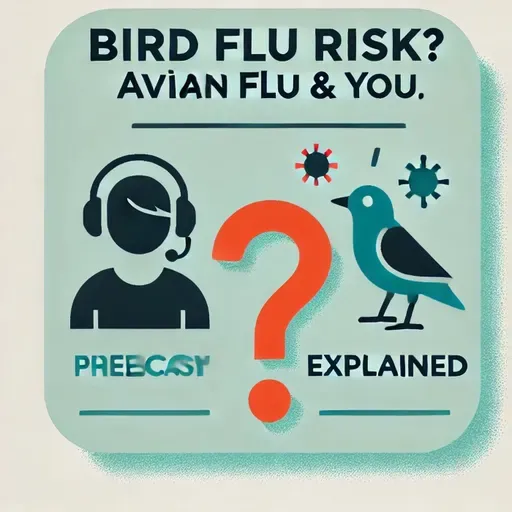
08 September 2025
Bird Flu 2025: Expert Guide to Understanding Your Risk and Staying Safe from Avian Influenza
Bird Flu Risk? Avian Flu & You, Explained
About
Welcome to Bird Flu Risk? Avian Flu & You, Explained—a Quiet Please production. I’m glad you’re tuning in, because understanding your real risk from avian influenza—commonly called bird flu—is key to staying healthy and calm, especially with headlines buzzing about outbreaks in 2025.
Let’s start with the big picture. According to a July 2025 joint assessment from the World Health Organization, Food and Agriculture Organization, and the World Organisation for Animal Health, the global public health risk from bird flu viruses like H5N1 remains low. However, risk goes up for certain people based on occupation, location, age, and overall health.
If you work closely with birds—think poultry or dairy workers, veterinarians, or those in live bird markets—your risk is higher than average, especially if proper protective measures are inconsistent, or you’re in areas where outbreaks are reported. In the U.S., according to the Johns Hopkins Center for Health Security, farm workers are the most likely to be exposed, but even then, there’s no evidence of wide human-to-human spread. The highest human cases by far come from direct, intense exposures to infected animals.
Location also matters. Rural or agricultural communities near poultry farms or in regions where wild birds are tested positive—like parts of Central Europe, Southeast Asia, and recent isolated outbreaks in North America—face a somewhat greater risk. Urban dwellers and those without animal contact face far less.
Let’s use a “risk calculator” walk-through. Imagine you’re a healthy 35-year-old office worker in a big city, with no poultry or livestock contact. Your risk is extremely low—no more than from everyday flu viruses. Now, picture a 50-year-old with a chronic illness working in a poultry processing facility in a region with known H5N1 outbreaks. For that scenario, your risk increases, particularly if protective equipment isn’t used consistently or if outbreaks have recently been confirmed locally.
Age and health status add another layer. Children in close contact with backyard birds and older adults with underlying health problems may experience more severe symptoms if infected, though infection overall remains rare. For most healthy adults, especially without direct animal contact, bird flu risk stays low.
So what should you do? For high-risk individuals—like farm or poultry workers—wearing masks, goggles, gloves, and practicing excellent hygiene, such as frequent hand washing, is essential. Report any flu-like symptoms to a healthcare provider, especially after exposure to birds. For low-risk folks—most people—follow standard health guidelines. No need for masks at your local supermarket or to avoid eating chicken or eggs, as long as they’re cooked properly.
When should you worry? Be vigilant if you live or work where outbreaks are reported, especially with direct bird or livestock contact. Otherwise, stay informed but don’t panic—widespread human cases have not occurred, and reliable surveillance is ongoing.
Thanks for listening to Bird Flu Risk? Avian Flu & You, Explained. Come back next week for more information that matters to you. This has been a Quiet Please production. For more, check out Quiet Please Dot A I.
For more http://www.quietplease.ai
Get the best deals https://amzn.to/3ODvOta
Let’s start with the big picture. According to a July 2025 joint assessment from the World Health Organization, Food and Agriculture Organization, and the World Organisation for Animal Health, the global public health risk from bird flu viruses like H5N1 remains low. However, risk goes up for certain people based on occupation, location, age, and overall health.
If you work closely with birds—think poultry or dairy workers, veterinarians, or those in live bird markets—your risk is higher than average, especially if proper protective measures are inconsistent, or you’re in areas where outbreaks are reported. In the U.S., according to the Johns Hopkins Center for Health Security, farm workers are the most likely to be exposed, but even then, there’s no evidence of wide human-to-human spread. The highest human cases by far come from direct, intense exposures to infected animals.
Location also matters. Rural or agricultural communities near poultry farms or in regions where wild birds are tested positive—like parts of Central Europe, Southeast Asia, and recent isolated outbreaks in North America—face a somewhat greater risk. Urban dwellers and those without animal contact face far less.
Let’s use a “risk calculator” walk-through. Imagine you’re a healthy 35-year-old office worker in a big city, with no poultry or livestock contact. Your risk is extremely low—no more than from everyday flu viruses. Now, picture a 50-year-old with a chronic illness working in a poultry processing facility in a region with known H5N1 outbreaks. For that scenario, your risk increases, particularly if protective equipment isn’t used consistently or if outbreaks have recently been confirmed locally.
Age and health status add another layer. Children in close contact with backyard birds and older adults with underlying health problems may experience more severe symptoms if infected, though infection overall remains rare. For most healthy adults, especially without direct animal contact, bird flu risk stays low.
So what should you do? For high-risk individuals—like farm or poultry workers—wearing masks, goggles, gloves, and practicing excellent hygiene, such as frequent hand washing, is essential. Report any flu-like symptoms to a healthcare provider, especially after exposure to birds. For low-risk folks—most people—follow standard health guidelines. No need for masks at your local supermarket or to avoid eating chicken or eggs, as long as they’re cooked properly.
When should you worry? Be vigilant if you live or work where outbreaks are reported, especially with direct bird or livestock contact. Otherwise, stay informed but don’t panic—widespread human cases have not occurred, and reliable surveillance is ongoing.
Thanks for listening to Bird Flu Risk? Avian Flu & You, Explained. Come back next week for more information that matters to you. This has been a Quiet Please production. For more, check out Quiet Please Dot A I.
For more http://www.quietplease.ai
Get the best deals https://amzn.to/3ODvOta